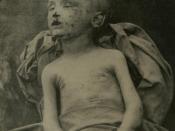It is taken for granted that the kingdom of Morocco presents a brilliant image of the Arabic African country which seriously aims at achieving a better situation for the Moroccan child. In recent years, Morocco, has given area attention to all fields relating to child hood. It has become a striking example in the fight for childrenÃÂs rights. UnlikelyThe limited resources of Morocco impedes the application of the full values and objectives of the Convention of childrenÃÂs rights. In this regard the Moroccan child still suffers from enormous problems on the top of which are child labour, strut children, and finally sexual exploitation.
At the beginning, child labour immensely exists in the Moroccan kingdom despite low restriction. A national employment survey conducted by the employment ministry and the International programmFor the abolition of children labour shows that 600,000 Moroccan children are working a large number of them in viral areas.
Such a phenomenon can be a scribed to a variety of reasons. The most important one is poverty. Many children in Morocco leave schools and work to ensure the survival of their family. In deed, the successive years of drought that have hit Morocco have extremely affected the financial status of the Moroccan and other developing countries look at the child as a profitable object which can contribute to household if the circumstance imposes so . Therefore, children in Morocco are prompted to by their parents to work study made by la ligue Marocain pour la protection des enfants shows that 72% of working children work due to penurity. Another important reason for child la bier is schooling problems. Truly, Morocco is doing a great work to ameliorate education. However the situation of the public is below the expectations. Many students stop studying because there is no access to schools, the long distance between studentsÃÂ houses and school stands as a stepping stone for them. This problem is mostly related to girls. Many girls cannot go to school, mainly junior and high ones, because the dwar and ksar are for and there are no means of travel. In Rissani, a Sahrawi cannot go beyond primary school, which leads her to learn handicraft. Moreover, the parentsÃÂ negative attitudes towards schools aggrandize the problem. This mainly concerns young rural children. In the countryside parent do not believe a diploma of any sort can help find a job. Hence, many parents do not give their children and in stead place them to acquire a hand craft and soon as possible they throw them in the employment market mainly boys but girls most of the time as young servants. The lack enfacement of labour perpetuates child labour. In Morocco, the age of admission is fixed at a minimum of 12 years of age by a royal Dahir on 12, 1947 and is still in effect. This limit is lower than the CCR. Ever worse, this legal restriction limited only for the formal sector, the informal one is irrespective of these laws. As a result, children are exposed to extreme exploitation in terms of toiling hours with minimal payment and in sever condition.
Additionally, street children are a perilous phenomenon which mainly affects the large and medium Moroccan cities. A study mode by the Moroccan secretary in charge of social protection and family indicated the number of street children in Morocco is about 10.000 & 14.000, the secretary of state in charge family and child hood imputes such a rise to many reasons. The most prominent is the deterioration of family bonds increasing poverty that trended the Moroccan family. Parents get unable to provide children with their basic necessities and children a adversely become the main source of revenue in large families. Also the progressive spread of some social ills such as: drug abuse, adultery, divorce contribute to the family disintegration In an interview with Dr. Najat Mjid, a pediatricians and founder of the Moroccan Association Bayti (My home), made by Maghrebie magazine, dr. MÃÂjid said the basic cause is family. The majority of these children come from poor and or problem families. We realized that the role of the family is almost nonexistent. The majority of these families suffer from the disappearance of fathers leaving the mother and children there fore, weak socio-economic status of families pushes children to leave the house searching for a better life in the street. Dr.MÃÂjid added the street offers a lot of freed on to these young people. Children who have been De pined of every thing find each other in the streets, this gives them a strong feeling of solidarity and belonging to a family. By contrast, the street life is the starting point of misery. From a report excerpted from Reuters Wafae Benani describes some moments of children in the streets As night empties the streets around MoroccoÃÂs main port of Casa Blanca, groups of young boys and sleep on fishing nets and on cartons in the wholesale market in door ways. In deed, when a child leaves his home, he certainly resorts to a life very similar with life in jungle. The exploitations that he faces are beyond anyoneÃÂs imagination. NAJAT MÃÂJIID, president of Association Baity said A bout 100.000 children live in the streets of CASA alone those children are certainly threatened by prostitution and delinquency NAJAT added 8% of children known to her had been sexually abused often by the eldest of their group or by tramps or men working as guards for cars and streets; in return, guards of cars let them sleep nearby. When a child leaves his house, he has a variety of works, the most accessible one is shoes shinning. This work is senrounded with evil company who try to make him a drug addict, particularly glue-sniffing. For girls, the situation of girls is a bit different A girl does not remain a lot outside. She soon finds a family to work at her house. However his environment is not always safe, very of ten, girls enter houses virgins and they go back to the streets as mothers. This harsh experience becomes the first step to prostitution.
Among the three problems stated be for, child sexual exploitation proves the most problematic in Morocco. This indecent phenomenon can be discussed through two major perspectives: boys prostitution and girls prostitution. For the former, the primary cause of boys entering prostitution is that their families send them out for employment, such boys are most of the time illiterate or come from rural areas. That is, the problem related to urban areas. Boys soon get shocked when they arrive to the cities. Job opportunities are scarce and when a child finds a job, he may be exposed to sexual exploitation their by the boss or the elder pier who are usually addicts of drugs. Deplorably, when they find little resistance, they tempt him to use drugs mainly glue sniffing. This addition, viciously, becomes a way of pressure, the need for money and glue sniffing make the child submit easily to their in human lust. Some other children choose to go abroad illegally including life threatening methods. Such children are at a great risk of drowning and after the trip their illegal situation obliges them to accept any behaviour to keep hidden and working in block. In most cases they face sexual abuse by bosses and even the ocean safeguards. Concerning girls, they often go to the street searching for a piece of bread. These girls always resort to being ÃÂpetites bonnesÃÂ or textile factories. Devoid of the necessary love and protection, these innocent girls are vulnerable to sexual abuse by the first fox she comes across. On the 3 of February, TVM shows a TV program ÃÂFamiliesÃÂ and which reflects the situation of single-mothers. Fatima, a girl of 18 years was violated by a detective while working at his house as a child maid. If Fatima had not found the association Baiti, she would have been a whore as many others whose direction after such incidents was EL HAJEB or pornography on a worldwide scale.
FootnotesÃÂ Bureau of International Labor Affairs ÃÂ Incidence and Nature of Child LaborÃÂ 2005ÃÂ Lahlou, M Child Labour in Morocco 2000ÃÂ The Employment Ministry ÃÂnational employment surveyÃÂ 2004ÃÂ MÃÂjid, N A Situational Analysis of Commercial Sexual 2003Exploitation of Children in MoroccoÃÂ Bennani, W ÃÂMorocco Street ChildrenÃÂ 1996





